Paddleboarding with Your Dog: 7 Important Steps to Successfully SUP with Your Pup
Paddleboarding with your dog? Why not! Fido already accompanies you on walks throughout town and secluded hikes in the wilderness, enjoys retail therapy at dog-friendly stores, and is the life of the party at the occasional patio restaurant or brewery. So, why wouldn’t we let man’s best friend enjoy the beautiful summer sunshine and the opportunity to cool off in the water? When we put it that way, it seems like a no-brainer. But where would you even begin? Keep reading to learn 7 important steps to successfully SUP with your pup!
1. Mastering Paddleboarding Basics – Ensuring You Are Comfortable on Your SUP First
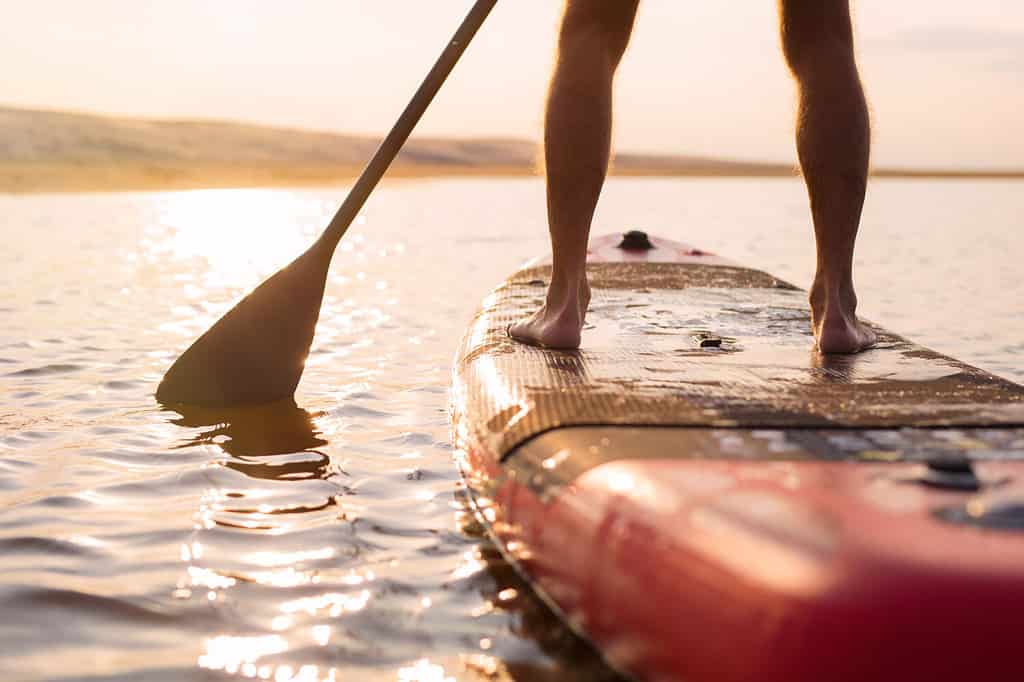
©Kaspars Grinvalds/Shutterstock.com
You’ve seen the picturesque views all over social media: A couple relaxes on their boards watching the sun leisurely set over the water. A fit woman balances, seemingly effortlessly, on her paddleboard while holding a gravity-defying yoga pose. A man and his furry best friend cruise naturally, even while paddling through choppy salt water.
These people are living your dream and you’re ready to make it your reality. But as easy as these scenes feel, paddleboarding is a form of exercise and you need to feel comfortable standing on your own two feet solo before welcoming your beloved dog aboard. It’s crucial to grow accustomed to the feel of your weight shifting on the board, to master steering, and to explore the many challenges you may face while out on the water. You’ll want to ensure you can navigate a quickening river or creek currents, maintain your balance despite choppy wakes from passing boats, and keep a keen eye out to avoid shallow-water obstacles that could fling you from your board.
2. Is Your Paddleboard Pup Safe?
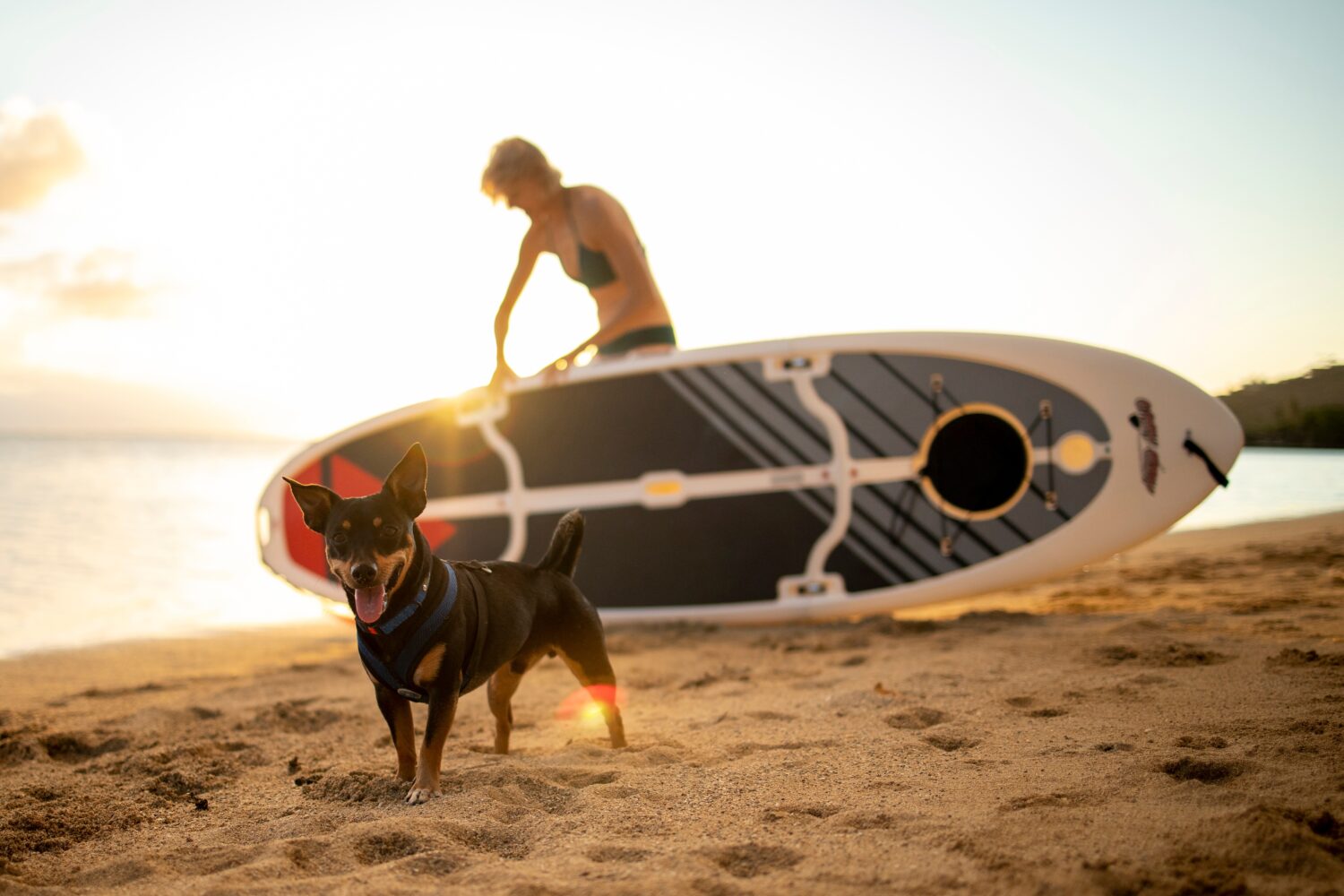
©Cavan-Images/Shutterstock.com
Whether you’re an experienced paddler with an arsenal of boards and boats in your garage, or new to the paddling world shopping for your first SUP, you must ensure you have a paddleboard that can safely accommodate both you and your dog. When planning your pup’s first excursion, keep these three SUP must-haves in mind:
Lean Towards Comfort Over Speed
Narrow boards are sleek and fast, but not typically a great choice for medium and larger dogs. Balancing on long, slender paddleboards can often be challenging on its own, depending on water conditions, so adding 45 pounds of furry excitement can easily lead to an afternoon of mostly (unintentional) swimming and less paddling.
Sufficient Weight Capacity
Are we paddling or are we sinking? When considering the perfect SUP for both you and your pup, make sure the board’s weight capacity can easily accommodate you, your dog, and any gear you plan to regularly take on the water with you.
Dog-Safe Surface Area
We’ve all seen the funny paddling bloopers where a dog skids off a paddleboard and falls comically into the water, but for the safety of both your dog and you, it’s important to minimize this risk as much as possible. To do so, ensure there is plenty of room on your paddleboard offering a good grip surface for your pup. Also, you’ll want to minimize bungees or cargo in the dog’s space, so your pup doesn’t trip or become entangled and hurt.
3. Encourage Your Dog to Become One with the Paddleboard
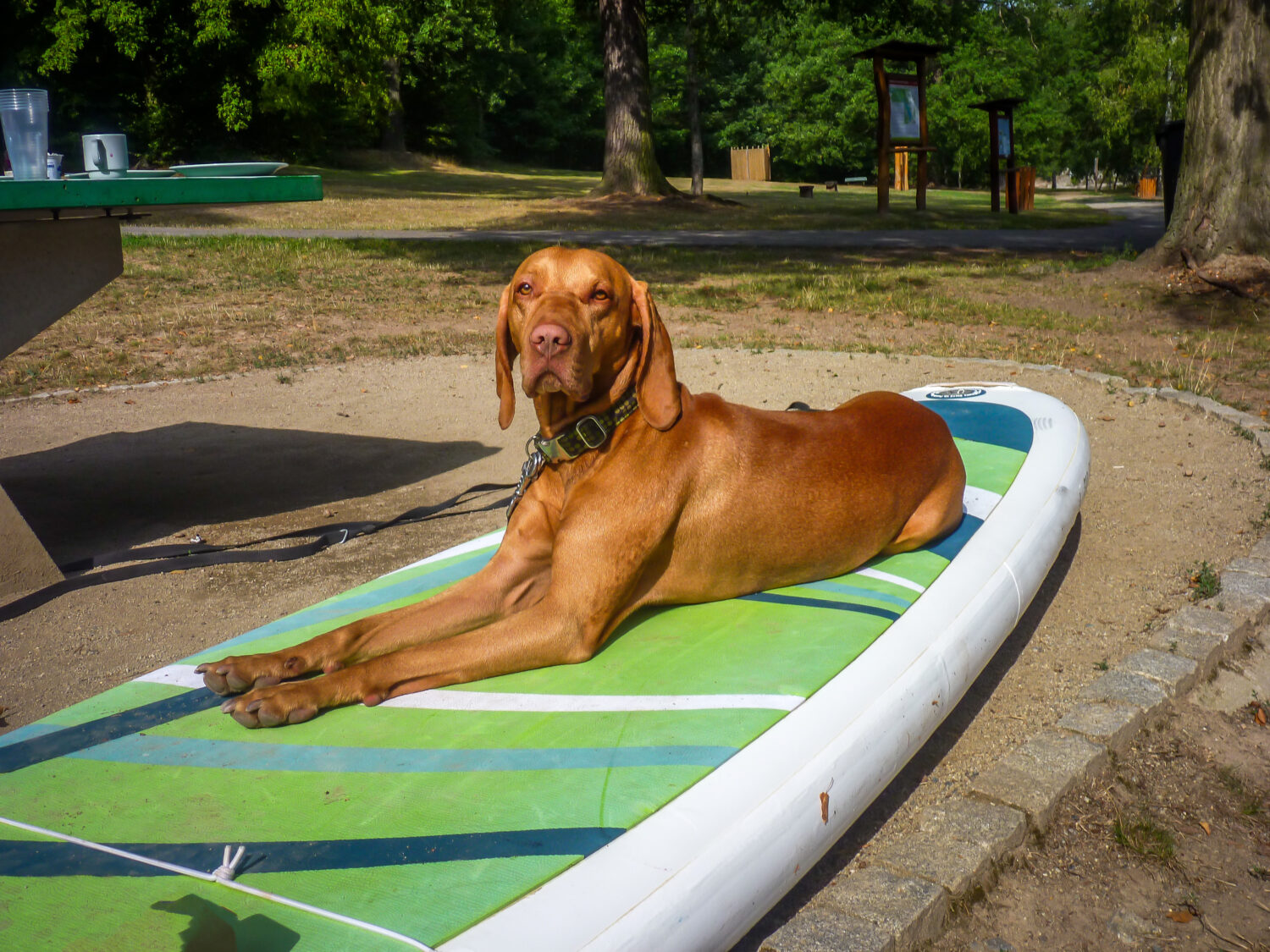
©Martin Minarik/Shutterstock.com
So, you’ve become comfortable paddleboarding and are confident your board is dog-friendly – what’s next? It’s finally time to introduce this strange, new contraption to your furry friend! Before venturing out onto the water, allow your dog to grow accustomed to your SUP in a safe space. Lay your board out flat on the porch or even in your living room, allowing your dog to see, sniff, and walk on the board. You may need to remove the fins from the bottom of your board, to keep it flat and stable for your dog. The goal is to eliminate any fear your pup may have of the SUP.
Once the dog has adjusted to the presence of the board, it’s time to start laying the training groundwork. Use plenty of treats to lure your pup onto the board and reward them to help grow their confidence. As this becomes a fun game, you’ll want to start using a command word to communicate it’s time for the dog to get on the board. This will become a great tool if you stop to take bathroom or playtime breaks on shore but are ready to get back out onto the water, or if you’ve let your dog off to swim and now want him back on the SUP.
4. Look Forward to Fun, but Plan for Safety
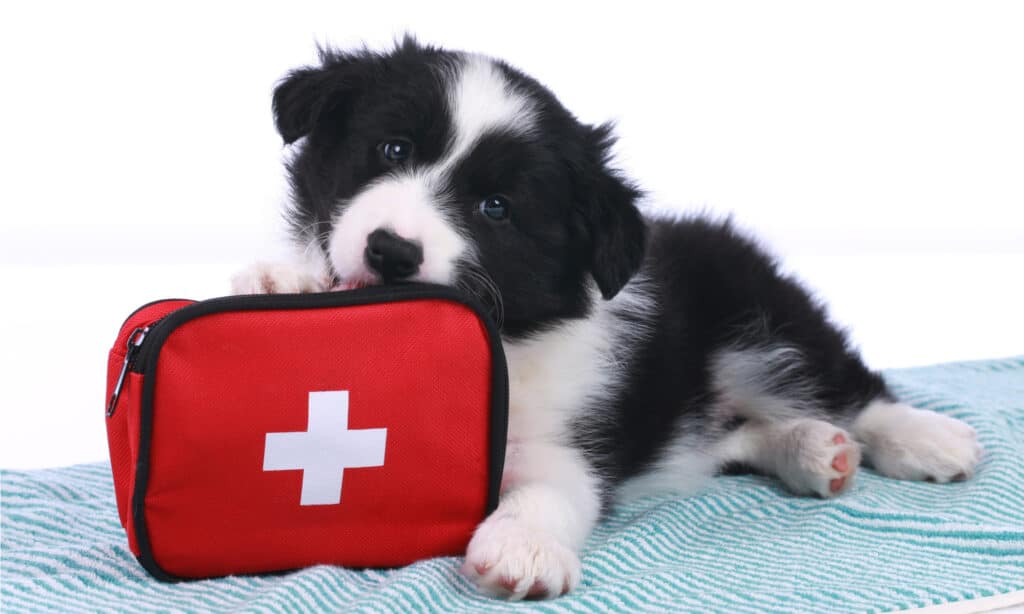
©absolutimages/Shutterstock.com
You’re almost ready to hit the water! The summer sun is beating down and you just can’t wait to cool off at the lake. But before you venture out, make sure you have the following items loaded up to ensure everyone’s safety:
A Dry Bag
This piece of equipment should accompany you on every trip. Make sure you have some sort of dry bag to place important items, such as keys, your wallet, your cell phone, and first aid supplies.
PFD (Pup Flotation Device)
The doggy paddle swimming style is named after man’s best friend. Your dog should be fine in the water, right? Not necessarily. Some dogs take to swimming more quickly than others, such as Labrador retrievers, which were bred to retrieve waterfowl. However, even the Michael Phelps of the canine world will tire over time. Invest in a sturdy lifejacket for your dog with a durable handle to help your pup back on board as needed. Make sure your pup’s life jacket is an easy-to-see, bright color and has reflective pieces to help with visibility as the sun sets. As an owner of a 65-pound mixed-breed dog who LOVES to swim, I recommend the Ruffwear Float Coat Dog Life Jacket. Pulling her back on board repeatedly has broken the handles of many lower-end life jackets, but our Ruffwear Float Coat is still going strong three years later.
Human Life Jacket
Just like your dog, you’re likely to grow tired after a long, warm afternoon on the water and an unexpected splash session could quickly become dangerous. While it’s always recommended to wear a personal flotation device, many state laws require every vessel (yes, even kayaks and SUPs) to have at least one flotation device, a whistle, and a light if venturing out after dark.
Sunscreen
The sun’s rays can be unforgiving. It may already seem like second nature to throw sunscreen in the car or your dry bag, but did you know that dogs can get sunburned, too? Check for patches where fur may be thin, like the head and feet. White patches of fur can be especially susceptible to sunburn, as well! Search dog-safe sunscreen options on Chewy here.
Eye Protection
As mentioned before, you’re not the only one requiring protection from the sun. “Just like for humans, UV light or UV radiation can be harmful to your dogs’ eyes and skin,” shares Rex Specs, a manufacturer of dog goggles that provide canines with UV eye protection. “Along with causing painful sunburns and increasing skin cancer risk, these smaller wavelength UV rays can get into eye tissue and degrade function.” Extended exposure to harmful UV rays can result in dogs developing cataracts, Cancer, and macular degeneration, among other conditions. So, if you’re wearing sunglasses out, it’s a good idea for your dog to do so, as well.
First Aid Kit
Whether adventuring with your pup on land or in the water, it’s important to always have a first aid kit readily available should an emergency arise. First aid kits can be kept in the car, if you’re able to return to it quickly and easily, or carried on board your paddleboard for longer excursions. Click here to learn more about the best first-aid kits for our furry friends!
Lights for Night Paddles
While you may not venture out after dark as you and your pooch first get acclimated to your paddleboard, sunset, and full moon paddles are a great way to soak up all the fun summer has to offer. When enjoying the water after dark, ensure everyone’s safety by affixing glow sticks or other lights to yourself, your dog’s life jacket, and your SUP. Visibility is crucial – especially when there are other boats with motors on the water.
5. Plan Your Perfect First Pup Paddleboarding Trip

©Kurt Nichols/Shutterstock.com
Your dog has become a professional living room paddleboarder, and you have all your gear ready to go. What’s next? It’s time to plan your perfect first paddleboarding trip for you and your pup.
Determine Your First Trip Destination
For a first outing on the paddleboard, you’ll want to take your dog somewhere with calm waters and minimal distractions. A smaller, secluded lake is a perfect spot for your pup’s maiden voyage on your SUP. Smaller lakes can commonly have restrictions regarding the size of the vessels permitted, and only having small fellow boaters on the water can help reduce the size of the waves you’ll encounter. Additionally, try to find lakes or boat launches that are less popular, allowing your furry friend to focus on you and learning to paddleboard, instead of other lake visitors. Need help deciding? Search our current articles on the best lakes to find a great spot near you!
Locate the Closest Emergency Vet
Taking your dog out for your first paddleboarding trip may be exciting, but don’t forget that there’s always a possibility something could go wrong. Keep printed copies of your pup’s vaccination records on hand when adventuring and determine the closest emergency vet near your destination before you leave, just in case you don’t have cell service while you’re out. Now more than ever, the veterinary medicine field is struggling to keep up with demand, so follow your local emergency vet offices on social media to be kept up to date on any scheduled closures.
Trim Fido’s Nails
Leading up to your first adventure, a very important grooming tip is to make sure your dog’s nails have been trimmed and, if possible, filed smooth with a nail grinder. Whether your paddleboard is fiberglass, foam, or inflatable, you’ll want to protect it from any damage that could be caused by your dog’s nails when trying to balance, jump in, or climb back onto the board. Additionally, it’ll help minimize any scratches to yourself while assisting your doggy paddler back onto your SUP after taking a dip.
Exercise Enthusiastic Pups
If you’re the proud owner of an overly excitable wigglebutt, it may be best to consider taking them for a stroll or playing a game of fetch before paddling. By burning some of your furry friend’s energy first, you’ll be able to approach your first paddle together a little more calmly and hopefully minimize accidental capsizing.
Keep Tabs on the Weather
While many people aren’t the biggest fans of getting caught in the rain on their paddleboards, an overly sunny day may not be a guaranteed perfect time to SUP with your pup. When paddling, it’s important to take into consideration how warm your pooch may be out on the water – especially with the added insulation of a life jacket. Check out our article to learn about how hot is too hot for dogs, and monitor your pups while out on the lake. Provide fresh drinking water regularly and allow your pup to hop overboard to cool down as needed.
6. Time for the Doggy Paddle

©Personal Photo – License
The sun is shining, the wind is just right, and your furry friend knows you’re going on an adventure. Today’s the day – you’re finally getting out onto the water with your pup. But, what’s the best way for Fido to get their paws wet?
Dip Your Toe
If your pup hasn’t spent much (or any) time in the water previously, take a moment somewhere quiet to introduce them to the lake without the paddleboard. Let your furry friend wade in on their own, offering treats and verbal positive reinforcement to ensure this is a fun experience and not scary. If completely brand new to being in the water, it’s a great idea to see how deep you can coax them and to see if they start paddling on their own. It’s important to encourage your dog to try this fun, new activity, without aggressively forcing them beyond their comfort zone. We want this to be an enjoyable experience – not a traumatic one.
Time for a SUP Pup
Once your dog has become acclimated to their life jacket and the water, take them and your board to a very shallow area and use the command you’ve assigned to communicate that you want the dog to hop up on the paddleboard. Praise your dog and offer treats to help them feel confident in this behavior, and try to discourage them from jumping off without giving them a release word to do so. It’s important not to condition them to think they have free reign to leave the board as they please – unexpected furry departures from your paddleboard could result in an unplanned swimming session for you.
Join in on the Fun
After your dog starts feeling comfortable on the floating paddleboard, it’s time for you to join the fun. Begin in a seated position on the board to minimize your risk of falling into the water. As you both become more comfortable on the SUP together, start experimenting in slightly deeper waters, and create a game plan on how you will get your dog back on the board if they jump or falls off. For heavier dogs, you can hold your paddle in the water on the side opposite of your dog to help counterbalance while you pull them up. Additionally, you can offer your dog your leg (while you’re seated) as a step so your dog can climb back onto the board. If you haven’t already, it’s also a good time for you to practice getting back on the paddleboard yourself, if you end up swimming.
Enjoy Yourself, but Don’t Overdo It
Now that you’ve practiced paddling with your dog and worked out a plan on getting both yourself and your dog back on board as necessary, you can start exploring deeper waters, as well as work your way up to kneeling on your paddleboard, and eventually fully standing. If your dog wants to hop in to cool off, you’ll want to kneel or sit, to help maintain balance when they jump into the water. As you soak in the beautiful weather from your paddleboard, please remember to do check-ins regularly for both you and your dog to make sure you aren’t becoming too fatigued. Is your dog new to a more active lifestyle? Check out our article on how much daily exercise your dog needs. Please remember that these recommendations are a goal to work up to if your dog’s lifestyle was previously more relaxed.
To Leash or Not to Leash
While leashing your dog is typically synonymous with safety, paddling is one time you shouldn’t. Most leash laws require you to keep dogs restrained in parking lots and at boat launches, but once you and your dog are out on the water, you should unhook your dog. If you capsize or if rough waters cause your pooch to fall overboard, a leash can easily become entangled in gear or nearby debris, which could result in a severely dangerous scenario and even risk death by drowning. If you’re the loving owner of a young, excitable pup who doesn’t reliably obey commands, consider starting with short paddleboard sessions in safe, shallow waters where you can focus more on training until they can be trusted off-leash.
7. Wrap It Up (And Towel Dry)
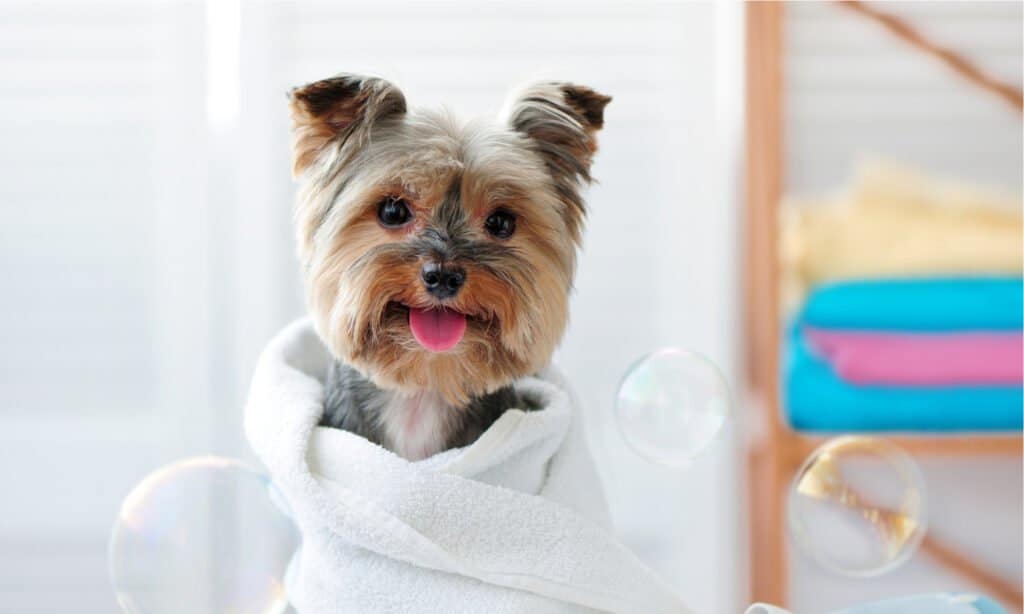
©Kasefoto/Shutterstock.com
You did it! Both you and your dog had a blast and you’re excited to be able to spend your summer free time paddleboarding together. Now, you’re home, unloading the car, and hanging gear out to dry. However, don’t forget to do a safety check on your furry friend! It’s important to at least rinse down your dog once home to clear their coats of itchy and dirty debris, and any freeloading bugs or bacteria they may have picked up at the lake. While rinsing your dog, also do an overall safety check. Look for any cuts on their paw pads from sharp rocks, check that there are no cracks or breaks in their nails, and watch their behavior to see if they are shaking their heads or scratching at their ears. These could be signs of water in the ears, which could lead to an uncomfortable ear infection.
Now, Enjoy Paddleboarding with Your Dog
Seeing picturesque views from your paddleboard on your own or with friends is memorable, but sharing this experience and building trust with your SUP pup is in a league of its own. By setting yourself up for success with the right board, proper safety equipment, and thorough training, you and your dog can enjoy a fun and enriching experience, that also guarantees a good night’s sleep after. So, gear up, be safe, and enjoy nature from your paddleboard with man’s best friend.
Quick Summary: 7 Important Steps to Successfully SUP with Your Pup
| 1 | Ensure You Are Comfortable on Your SUP First |
| 2 | Make Sure Your SUP Is Pup Safe |
| 3 | Introduce Your Dog to Your Paddleboard – at Home |
| 4 | Hope for Fun, but Prepare for Safety |
| 5 | Plan Your Perfect Pup Paddleboarding Trip |
| 6 | Time to Doggy Paddle |
| 7 | Rinse Your Dog and Look Forward to Your Next Trip |









